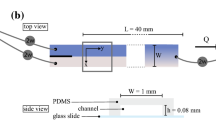Abstract
Psoriasis is a common skin disease, with a clinical appearance of red, scaly lesions, known as plaques. Recent experimental research has shown that the ubiquitous cell-signalling molecule nitric oxide (NO) is actively synthesized within these plaques by the iNOS enzyme. In contrast, NO production from normal, healthy skin is a by-product of the reduction of nitrite in sweat. Measurement of NO release rates at the skin surface are 100 times greater from psoriatic lesions than normal skin. We propose a mathematical model for the dynamics of NO within psoriatic plaques, that incorporates diffusion, production in the basal epidermis, decay within the plaque, and active scavenging by red blood cell haemoglobin; this last effect introduces a key nonlinearity into the model. We present numerical simulations of the model in two space dimensions, and then describe an approximation that reduces the model to two coupled ordinary differential equations. This reduced system can be solved exactly, giving an approximation for the NO release rate as an explicit function of model parameters. We use this approximation to explain some recent, surprising experimental results.
Similar content being viewed by others
References
Auer, T., M. Bacharach-Buhles, S. el Gammal, M. Stücker, B. Panz, C. Popp, K. Hoffmann, M. Happe and P. Altmeyer (1994). The hyperperfusion of the psoriatic plaque correlates histologically with dilation of vessels. Acta Derm. Venereol. S186, 30–32.
Bruch-Gerharz, D., K. Fehsel, C. Suschek, G. Michel, T. Ruzicka and V. Kolb-Bachofen (1996). A proinflammatory activity of interleukin 8 in human skin: expression of the inducible nitric oxide synthase in psoriatic lesions and cultured keratinocytes. J. Exp. Med. 184, 2007–2012.
Ignarro, L. J., R. E. Byrns, G. M. Buga and K. S. Wood (1987). Endothelium derived relaxing factor from pulmonary artery and vein possesses the pharmacologic and chemical properties identical to those of nitric oxide radical. Circ. Res. 61, 866–879.
Klemp, P. and B. Staberg (1983). Cutaneous blood flow in psoriasis. J. Invest. Dermatol. 81, 503–506.
Kolb-Bachofen, V., K. Fehsel, G. Michel and T. Ruzicka (1994). Epidermal keratinocyte expression of inducible nitric oxide synthase in skin lesions of psoriasis vulgaris. Lancet 344, 139.
Krischel, V., D. Bruch-Gerharz, C. Suschek, K. D. Kroncke, T. Ruzicka and V. Kolb-Bachofen (1998). Biphasic effect of exogenous nitric oxide on proliferation and differentiation in skin derived keratinocytes but not fibroblasts. J. Invest. Dermatol. 111, 286–291.
Krogstad, A. L., G. Swanbeck and B. G. Wallin (1995). Axon reflex mediated vasodilation in the psoriatic plaque? J. Invest. Dermatol. 104, 872–876.
Ku, D. D. (1996). Nitric oxide and nitric oxide donor induced relaxation. Methods Enzymol. 269, 107–119.
Lancaster, J. R. (1994). Simulation of the diffusion and reaction of endogenously produced nitric oxide. Proc. Natl. Acad. Sci. USA 91, 8137–8141.
Liao, J. C., T. W. Hein, M. W. Vaughn, K. T. Huang and L. Kou (1999). Intravascular flow decreases erythrocyte consumption of nitric oxide. Proc. Natl. Acad. Sci. USA 96, 8757–8761.
Maeda, H., T. Okamoto and T. Akaike (1998). Human matrix metalloprotease activation by insults of bacterial infection involving proteases and free radicals. Biol. Chem. 379, 193–200.
Malinski, T., Z. Taha, S. Grunfeld, S. Patton, M. Kapturczak and P. Tomboulian (1993). Diffusion of nitric oxide in the aorta wall monitored in situ by porphyrinic microsensors. Biochem. Biophys. Res. Commun. 193, 1076–1082.
Moncada, S. (1999). Nitric oxide: discovery and impact on clinical medicine. J. R. Soc. Med. 92, 164–169.
Okamoto, T., T. Akaike, T. Nagano, S. Miyajima, M. Suga, M. Ando, K. Ichimori and H. Maeda (1997). Activation of human neutrophil procollagenase by nitrogen dioxide and peroxynitrite: a novel mechanism for procollagenase activation involving nitric oxide. Arch. Biochem. Biophys. 342, 261–274.
Orem, A., R. Aliyazicioglu, E. Kiran, B. Vanizor, G. Cimnocodeit and O. Deger (1997). The relationship between nitric oxide production and activity of the disease in patients with psoriasis. Arch. Dermatol. 133, 1606–1607.
Ormerod, A. D., C. M. Dwyer, R. Weller, D. H. Cox and R. Price (1997). A comparison of subjective and objective measures of reduction of psoriasis with the use of ultrasound, reflectance colorimetry, computerized video image analysis and nitric oxide production. J. Am. Acad. Dermatol. 37, 51–57.
Ormerod, A. D., R. Weller, P. Copeland, N. Benjamin, S. H. Ralston, P. Grabowksi and R. Herriot (1998). Detection of nitric oxide and nitric oxide synthases in psoriasis. Arch. Dermatol. Res. 290, 3–8.
Savill, N. J., R. Weller and J. A. Sherratt (2002). Mathematical modelling of nitric oxide regulation of rete peg formation in psoriasis. J. Theor. Biol. 214, 1–16.
Thibodeau, G. A. and K. T. Patton (1997). The Human Body in Health and Disease, St Louis: Mosby Year Book Inc.
Weller, R. and A. Ormerod (1997). Increased expression of nitric oxide synthase. Br. J. Dermatol. 136, 132–148.
Weller, R., A. Ormerod and N. Benjamin (1996). Nitric oxide generation measured directly from psoriatic plaques by chemiluminescence. Br. J. Dermatol. 134, 569.
Ziche, M., L. Morbidelli, E. Masini, S. Amerini, R. H. J. Grange, C. A. Maggi, P. Geppetti and F. Ledda (1994). Nitric oxide mediates angiogenesis in vivo and endothelial cell growth and migration in vitro promoted by substance P. J. Clin. Invest. 94, 2036–2044.
Author information
Authors and Affiliations
Rights and permissions
About this article
Cite this article
Sherratt, J.A., Weller, R. & Savill, N.J. Modelling blood flow regulation by nitric oxide in psoriatic plaques. Bull. Math. Biol. 64, 623–641 (2002). https://doi.org/10.1006/bulm.2001.0271
Received:
Accepted:
Issue Date:
DOI: https://doi.org/10.1006/bulm.2001.0271




